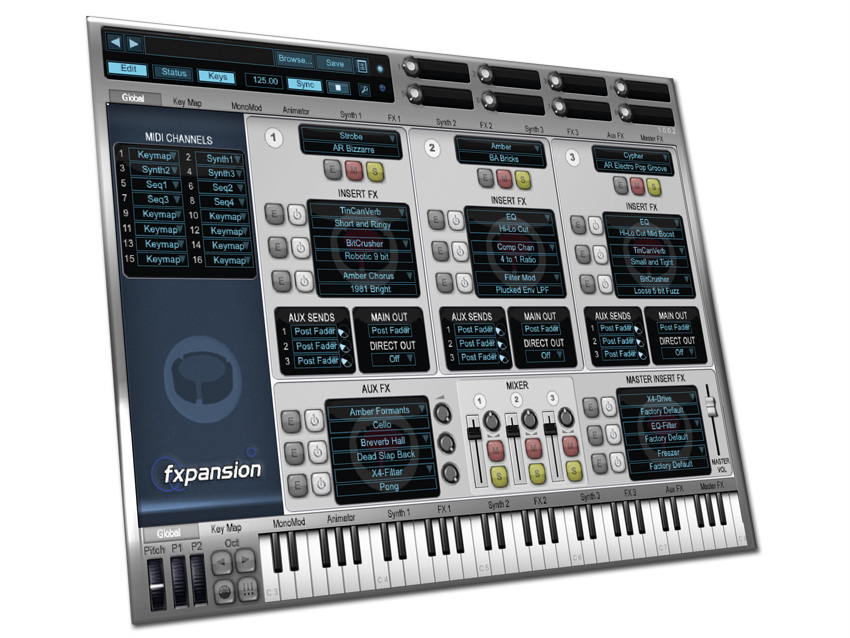MusicRadar Verdict
Get to know the members of Synth Squad and you'll make a powerful ally in your quest for superior sounds.
Pros
- +
Comprehensive Fusor shell. Top-notch sound throughout. Handy Ramp modulators. Cypher's Beat knob is a neat touch. Amazing modulation system. Visualisation scope.
Cons
- -
Can be CPU-intensive. Complexity can be overwhelming.
MusicRadar's got your back
Putting aside the rather minimal freebies Orca and Mysteron (remember them?), DCAM: Synth Squad is the first synthesizer product from plug-in veterans FXpansion.
The package includes three synths - Amber, Cypher and Strobe - and while each has its own sonic speciality, they share some common parameters and a unified modulation system. The package also includes a shell instrument, Fusor, enabling you to layer up the synths, add effects and more.
Strobe
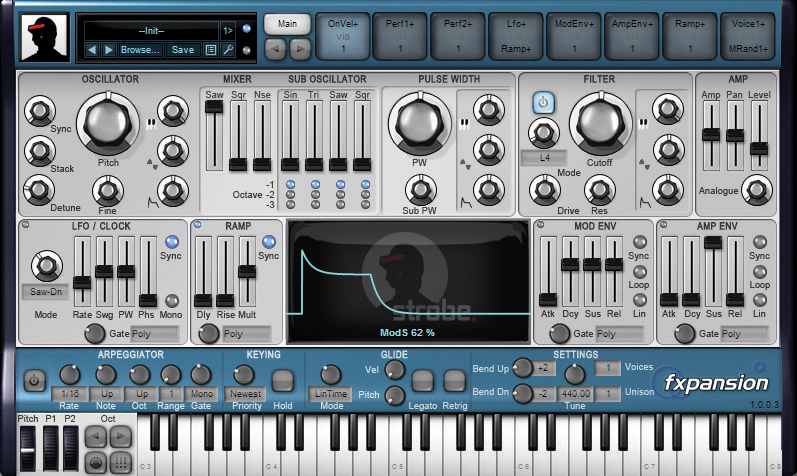
The simplest of the synths is Strobe, a subtractive job with a mixer that enables you to blend sawtooth, pulse and noise oscillators. In addition, you can mix sine, triangle, saw and square sub oscillators, each of which can be set to any of the three octaves below the root note.
The pulse width of the main oscillator and sub oscillators can be set independently, and there's a drivable, self-resonating multimode filter with a whopping 22 types to pick from.
For phattening things up, the Stack and Detune knobs essentially give per-oscillator unison of up to five voices - with Detune at the maximum setting, gradually increasing Stack introduces tones an octave above and below, then a fifth above and a fourth below - this is in addition to DCAM's generic unison capability. For creating hard sync effects, modulation of the Sync knob is absolutely where it's at.
Amber
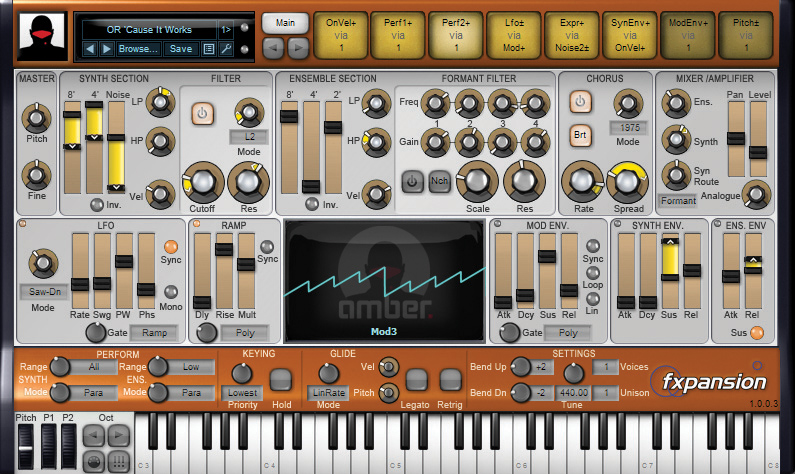
Amber is a little more exotic than Strobe, being based on the architecture of classic 'string machine' synths, such as the ARP String Ensemble. These achieve polyphony using 12 oscillators to create an octave's worth of notes that are then 'divided down' to lower frequencies to enable the full range of the keyboard to be utilised.
Amber has two sound-generating sections, each with their own amplitude envelope. One features standard 8" and 4" saw oscillators, plus a noise generator and a resonant multimode filter with eight filter types, while the other has 8", 4" and 2" divide-down sawtooth oscillators with a four-band formant filter and three-mode chorus effect.
Want all the hottest music and gear news, reviews, deals, features and more, direct to your inbox? Sign up here.
The amplitude envelope for the string section only has attack and release times, and has no voice number limits.
Cypher
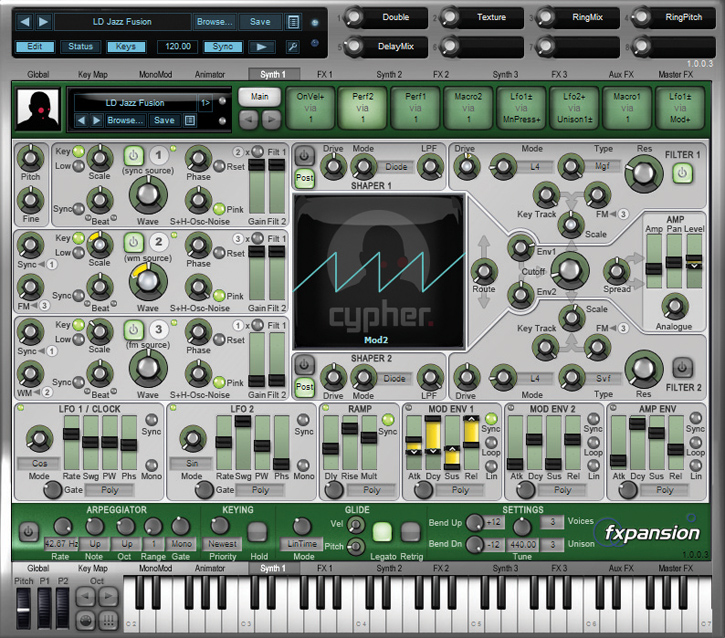
The final synth, Cypher, is potentially the most versatile, its speciality being audio-rate modulation. It boasts three oscillators, each with a Wave knob that goes smoothly from a triangle, on through sawtooth and square, into a pulse shape - ie, narrow pulse width.
Amongst other things, it's possible to dial in hard sync as a variable amount; ring modulate consecutive oscillators; modulate the filter cutoff at audio rate; and perform 'through zero' FM, where the frequency can be modulated to a negative value, causing the waveform to be reversed.
Although FM and ring modulation are associated with hard, 'digital' sounds, Cypher can sound phat and 'analogue', too, due to such features as its dual waveshapers and twin filters (SVF or Moog-style) with routing options. Like the other synths, it has a drivable mixer section with an Analogue knob that introduces noise throughout the virtual circuitry.
"The final synth, Cypher, is potentially the most versatile, its speciality being audio-rate modulation."
In any synth, when oscillators are detuned against each other, a rhythmic beating is created by the interaction between the tones, the regularity of this beating depending on the root note - this is most often exploited in throbbing DnB bass sounds.
Using Cypher's Beat knob, you can achieve this detuned beating, but with a constant rhythm across the keyboard - it's a unique touch that shows that FXpansion has thought about the needs of its users.
For modulation, Cypher has two LFOs, three envelopes and a Ramp modulator. We're rather fond of the latter - it's a simple envelope with delay, attack and sustain stages that's also found in Amber and Strobe and is ideal for delaying the onset of LFO-based modulations like vibrato.
Other common aspects include an arpeggiator, plus glide and voicing settings (with up to 16 unison voices). There are effects versions of each synth, too, for processing your audio through their filters and effects.
Modulation
The TransMod modulation system enables you to route multiple destinations from eight sources, each with a secondary source to, err, modulate the amount of modulation. Phew.
With one of the eight TransMod slots selected, you drag the outer ring of a knob (or track of a fader) to define as many modulation connections as you like, with the ranges shown in yellow.
Most unusually, unison detune is achieved via a special modulation source that you route to the fine pitch knob of a synth, causing the pitches of the voices to 'spread out'. The upshot of this is that it can be applied to any parameter; for instance, assign it to the pan control and the voices are panned across the stereo field.
In fact, there are loads of unusual modulation sources - all we're missing are multipoint envelopes and LFOs; however, LFOs do have advanced options such as swing. You can even use a TransMod slot to 'morph' the synth's settings to match that of another patch (incidentally, there are plenty of good - if not spectacular - presets supplied).
Fusor
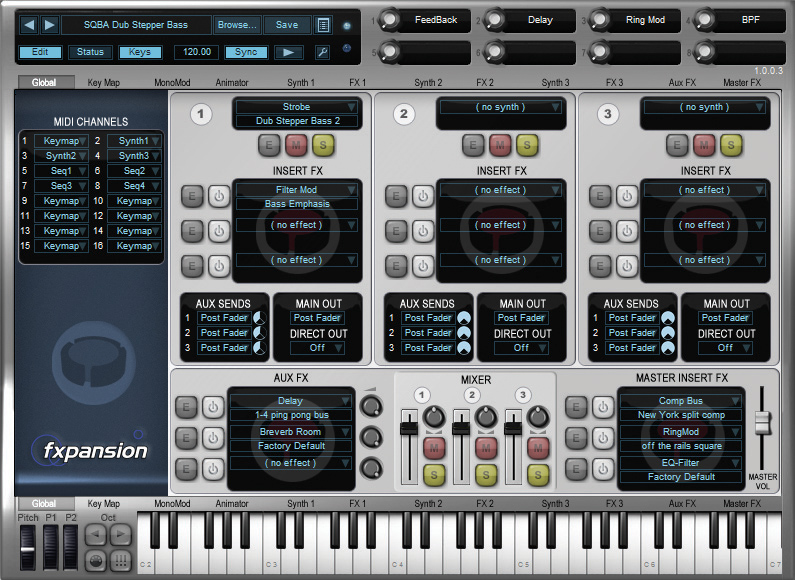
As well as the three individual synths, DCAM includes a shell instrument called Fusor that enables up to three synths to be stacked up together. It also features three insert effect slots per synth, three master inserts and three aux effects.
There are 27 quality effects to choose from, unexpected highlights being reverbs based on Overloud's Breverb, and the oddball Frequency Shifter and grain-based Freezer effects. The formant filter and chorus from Amber are also on hand as effect modules.
Fusor gives you yet more modulation sources to fool around with, including four LFOs, four envelopes (useful when pumping three synth instances through the same filter, for example) and eight macro knobs.
The step sequencer, Animator, has four sequence 'engines' of up to 128 steps. It can be used as an arpeggiator and/or modulation source, and features an Advanced mode with even more controls, such as modulatable offset knobs for the graph lanes.
Finally, key splits and fades can be created with Fusor's Key Map page. Although Fusor can't route audio between the synths, it still offers a monstrous amount of sound-sculpting potential through its modulation and effects processing capabilities.
Summary
Overall, DCAM is a great package, especially for experienced synth lovers, and it's capable of a huge range of tones, from hard and aggressive to those of the vintage variety, all with a fantastic quality of sound that puts it straight into the top tier of soft synths.
There might not be anything particularly revolutionary about DCAM - aside from perhaps Cypher's Beat function - but the quality, in-depth modulation and numerous neat touches all add up to make it an enticing prospect for synth maniacs.
Take a listen to what DCAM: Synth Squad can do
Computer Music magazine is the world’s best selling publication dedicated solely to making great music with your Mac or PC computer. Each issue it brings its lucky readers the best in cutting-edge tutorials, need-to-know, expert software reviews and even all the tools you actually need to make great music today, courtesy of our legendary CM Plugin Suite.
